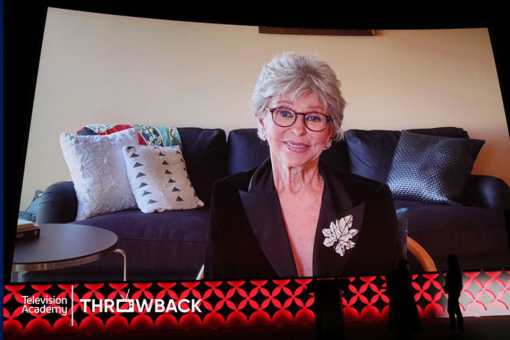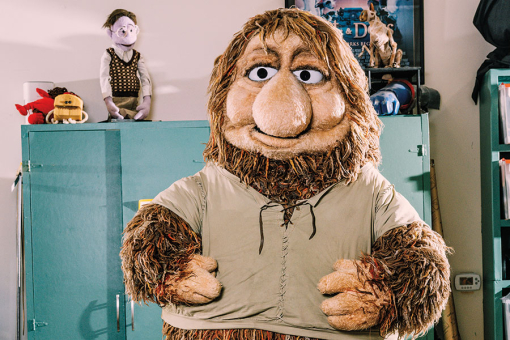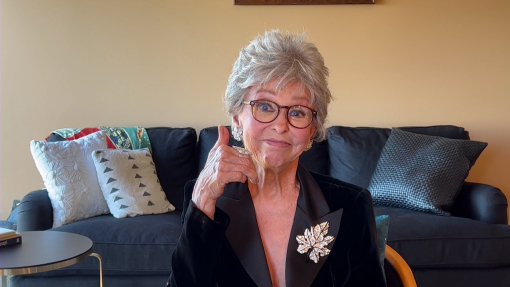When Kermit the Frog made his television debut, he became the patriarch of a new kind of creature, the Muppet, which utterly transformed one of the oldest art forms in the world.
Jim Henson launched his career with Kermit in 1954, when puppetry was still limited to awkward hand dolls and marionettes. Henson changed all that. Through his own genius and the technology of television, he brought to puppetry a greater fluidity, a wider range of expressiveness, and a larger canvas.
"Through his acquired knowledge of camera angles, lenses, and special effects, and through the use of imaginative editing and ingeniously designed sets, Henson has evolved a system that permits his puppet characters to move in “cinematic space” almost as freely as human performers … ," writes Christopher Finch in his book Of Muppets & Men:
On PBS’s Sesame Street, Henson and his Muppets became synonymous with quality children’s programming. In fact, it was that show, launched in 1969, which catapulted Kermit and some of Henson’s other Muppets — Big Bird, Oscar, Cookie Monster, Ernie, Grover, and Bert — to the fame they enjoy today.
Later, some of the same characters, along with the inimitable Miss Piggy, appeared in another Henson landmark, The Muppet Show, in which the master puppeteer proved he was also one of television’s master entertainers.
Having toiled in television’s vineyards for more than 30 years, Henson, whose work has harvested 21 Emmys, clearly belongs to that first generation of TV artists whose careers were launched by the new medium and whose efforts ultimately enlarged the medium’s dimensions.
“I love television,” he says. "With television it’s possible to break from tradition, and I always want to break from the limited way we’re doing things. The medium is capable of all kinds of things. But perhaps one of the reasons it doesn’t always reach for those things is because it is run like an industry."
Born on September 24, 1936, in Greenville, Mississippi, Henson grew up in suburban Washington, D.C., a teenage TV junkie. His other abiding interest was art, and he thought he might become a stage designer or set designer in television
His career began when he read one day that a local television station was auditioning for young puppeteers. This son of a government agricultural researcher didn't know anything about puppets, but he wanted a career in television. So he made a puppet out of his mother’s old green coat, named the creature Kermit the Frog, went to the audition, and secured the job. He soon found himself on a TV program called The Junior Morning Show. It was that simple — and that frightening.
At 18, Henson, a quiet, introverted, high school senior, discovered that performing in front of people was a terrifying experience. Even at 51, he says, he is still “petrified in front of an audience.” He prefers to reach an audience indirectly, through the credentials of another object. “For me,” Henson admits, “it’s easier to express who I am through something else, like a puppet.”
Henson overcame his performance terrors well enough to be offered, in 1955, a regular, five-minute spot on WRC-TV, an NBC affiliate in Washington. Since he was attending the University of Maryland as an art and design major, he asked his classmate and future wife, Jane Nebel, to help him do the show. They called it Sam and Friends. The ever-reliable Kermit became a regular, and Henson coined the term Muppet.
He was 19 years old when the late-night spot was first aired. By the time it ended eight years later, he had won a local Emmy for outstanding television entertainment. On Sam and Friends, he had acquired experience with every aspect of television production: writing, directing, designing, editing, producing, performing. Now he was ready to begin work on a broader canvas.
The experience gained on Sam and Friends, as well as the Muppets’ appearances as guests on various network shows, eventually led Henson to a regular prime-time slot. From 1963 until 1966, Henson’s Rowlf the Dog became a regular character on ABC’s The Jimmy Dean Show. Henson, via Rowlf, additionally served as a narrator on the CBS musical variety show Our Place, which aired as the 1967 summer replacement for The Smothers Brothers Comedy Hour.
But it was Sesame Street that put Henson’s career in high gear in the early 1970s. Using humorous material that was educational, fast paced, and imaginative, the Muppet segments of the show enchanted adults and children and helped it to become what it remains today: the standard by which all children’s programming is judged.
Remarkably, Sesame Street, now almost 20 years old, continues to charm its viewers. But while Henson still produces the Muppet segments, his efforts are not limited to that show.
Several years after Sesame Street’s 1969 debut, he began to explore options that might place the Muppets on their own network series. His production company, Henson Associates, approached ABC and CBS, but both networks expressed little faith in such a series, primarily because two ABC pilots, The Muppet Valentine Show (1974) and The Muppet Show: Sex and Violence (1975), had garnered poor ratings. Although by 1975 the Muppets were also filming several Saturday Night Live segments meant obviously for a more mature viewer, most network decision makers felt the Muppets could appeal only to children.
Some, fortunately, disagreed. Like the Saturday Night Live producers, ITC Entertainment believed Henson’s creatures could attract a broad spectrum of viewers. ITC, Lord Grade’s American subsidiary of Associations Communications Corporation, the British entertainment corporation, offered to syndicate Henson’s proposed series in the 7:30-8:00 p.m. time slot not controlled by the networks. Thus, Grade became, as Henson says, “a major person in my career.” Intrigued by Grade’s offer and tempted by his promise of complete creative independence, Henson moved his team to London to produce what was to be known as The Muppet Show.
The Muppet Show made its debut in the fall of 1976 and continued for five seasons. Winning wide critical acclaim, it became the most popular first-run syndicated series in television history, reaching hundreds of millions of viewers in more than 100 countries.
Kermit, Miss Piggy, Fozzie Bear, the Great Gonzo, Dr. Julius Stangepork, Foo-Foo, Scooter, Sweetums, Beauregard, Zoot the Saxophonist, Sergeant Floyd Pepper, Janice, Robin the Frog, Pops, Statler and Waldorf, as well as an assortment of singing vegetables, monsters, and other quasi earthlings, all contributed to The Muppet Show’s crazy-quilt personality.
As drama/satire/broad comedy, the show exposed a backstage world filled with personalities in the grip of controlled hysteria, mild mayhem, or “benign absurdity,” as writer Christopher Finch puts it.
Produced and co-written by Henson, who also served as a performer, The Muppet Show typically portrayed its characters in the throes of putting on their own outrageous production numbers. Confusion reigned as the Muppets, hungering for success on the boards, boasted, badgered, plotted, executed karate chops, flirted, and fell madly in love with the guest star of the evening. And through the years, the show attracted some of Hollywood’s brightest stars: Lena Horne, Carol Burnett, Bob Hope, Linda Ronstadt, Rudolf Nureyev, George Burns, Julie Andrews, Roger Moore, Sylvester Stallone, Diana Ross, Steve Martin, Paul Simon.
By the time The Muppet Show ended its run in the originals in 1981, the program had carried Henson a long way toward the artistic and financial independence he enjoys today.
Henson views the show as his most significant contribution to television. "The Muppet Show is probably the major piece we’ve done so far,” he says. “It was done with Muppets but written at an adult level.” More importantly, it broke new ground, he says, by “combining aspects of a variety show and a dramatic show” — a blend, he adds, which “might work today for other shows.”
The Muppets’ success in their own series led directly to their success on the silver screen, with The Muppet Movie (1979), The Great Muppet Caper (1981), and The Muppets Take Manhattan (1984). Henson also produced The Dark Crystal in 1982 and Labyrinth, starring David Bowie, in 1986.
Besides the perennial Sesame Street, Henson’s current television shows for children are Fraggle Rock, an international favorite shown in 85 countries and telecast in 13 languages, and Muppet Babies, which won its third consecutive Emmy this year. Another series, Jim Henson's The Storyteller, a family show based on folktales, made its debut this fall on NBC after the tremendous success of the Emmy-winning pilot in January of this year.
With The Storyteller, Henson is again unearthing new territory for television, this time in TV drama. “We’re using a technique borrowed from music videos of telling a story expressionistically,” he says.
After three decades of working in the medium he helped shape, Henson is still finding diamonds on the airwaves. And it all started with Kermit the Frog. Having revolutionized the art of puppetry and having made an indelible imprint on American television, Kermit’s maker, a restless artist, wants more diamonds.
What’s the next stop?
“We’re making a couple of films, and we’re involved in a couple of TV projects.” Henson declares. “There is still so much yet to do.”
This tribute originally appeared in the Television Academy Hall of Fame program celebrating Jim Henson's induction in 1987.










